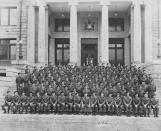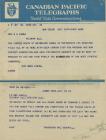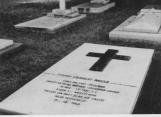1
05) Post War 1945 -1950- Reserve status
- Reconnaissance exercises
- Lt. Col. H. Angle to Kashmir
- Armoured again
- Trophies
- The Loss of Brig. Angle
4
In April 1946, barely two months following the return from overseas, the BCDs were reorganized as a Militia unit called the 9th Reconnaissance Regiment (BCD), under the command of Lt. Col. Angle. In 1949 the name changed to British Columbia Dragoons (9th Reconnaissance Regiment).'A' Squadron was reinstated in Vernon, 'B' Squadron and Regimental Headquarters (RHQ) in Kelowna and 'C' Squadron in Penticton. RHQ has remained in Kelowna since WW II, although it did shift to Vernon from time to time when the Regiment's Commanding Officer (CO) resided there. For much of that period 'HQ' Squadron made use of a wartime hut located behind Kelowna's Armoury.
Following the war Lt. Col. Angle reinstated the Regimental Ball, Annual Sports Day, Regimental dinners, smokers, and Squadron dances. For a number of years the Regimental Officers' Annual Mess dinner was held on 31 August, the anniversary of the Gothic Line battle. The BCD Rifle Association flourished again in competitions. It was open to members and non-members of the unit and was well received, as the cost was minimal. Members could purchase new Lee-Enfield rifles from the Canadian Government for $11.00 each and get unlimited ammunition from the Regiment simply by returning the empty cartridges. Not surprisingly, members of the Association demonstrated their proficiency in regular competitions up and down the Okanagan and in Vancouver.
The late 1940's the BCDs enjoyed a seemingly unlimited amount of fuel for the ample number of scout cars, Bren gun carriers, jeeps, ½ ton and 3 ton trucks with which the Regiment was equipped. There was fuel for extended Reconnaissance or "Recce" exercises like the 10-day excursion in 1946 to Peter Hope Lake in the Nicola Valley, and the return trip via Merritt, Princeton and Penticton.
Towards the end of his last term of command a Recce exercise was organized by Lt. Col. Angle to the south of Penticton and Merritt through what was to become the Hope-Princeton Highway. The Regiment managed to follow old trails such as the old Dewdney Trails of the gold rush era, rebuild parts of roads and bridges, and reach the area now marked by the Hope-Princeton Slide. Unfortunately, they could go no further because clearing the route had started and the road was covered with trees that had been cut and left lying on the ground ready for hauling from the Hope end of the valley.
Lt. Col. Angle was posted to the United Nation's Commission on the India/Pakistantani border dispute in the Kashmir, early in September 1947. Command of the unit passed to Lt. Col. David Kinloch who was formerly a squadron commander in Italy. The Regiment now became part of the 27th Armoured Brigade with headquarters in Esquimalt.
6
They also used the US built Stuart tank, with its 37mm gun, as a scout vehicle.1950
Glenemma Range, Glenemma, BC, Canada

7
Some veterans of the Regiment's campaigns overseas stayed on in the Dragoons who provided invaluable instruction and example to the new recruits who began to join in respectable numbers from the late 1940's to the mid-1950's. A noted example of this type of commitment was R. W. (Bob) Hodgson who had joined the Regiment in 1929. He became Regimental Sergeant-Major (RSM) at Camp Borden in 1941 before serving in that capacity during the Active Force unit's campaigns in Italy and NW Europe, and later with the militia unit until retirement in 1960. At that time he was the longest serving RSM in the Canadian Army.The Regiment received tanks at various times during this period: Honeys, Stuarts, and even Shermans. It had a good number of 6 pounder anti-tank guns, .50 calibre heavy machine guns and .30 calibre machine guns. The Glenemma training area northwest of Vernon was the site of many weekend range exercises with smaller tank guns and small arms. The expense of tank training meant that much of the training during the year at squadron headquarters would involve training aids and simulators. The summer, and even some winter, camps were now held in Wainwright, Alberta, where training was held for gunners, operators and drivers.
Within a few years of the end of WW II hostilities broke out in Korea. Initially, a troop of Dragoons was sent to fight as part of 25th Brigade, which was part of the UN force dispatched to the Far East. Lt. Col. Kinloch was unable to find a troop leader so the members of the Dragoon troop were re-badged as part of the Lord Strathcona's Horse (RC) before going to Korea.
In 1948, Lt. Col. Angle once again left Kelowna for duty overseas and was promoted to Brigadier as the Chief Military Advisor to the UN Military Observer Group in India and Pakistan. Tragically, on July 17, 1950 while in the Kashmir, he was killed in a plane crash while en route between Karachi and New Delhi.
The training in which the Regiment has engaged since WW II, yielded tangible results in the form of trophies. In 1949 and 1950 the Regiment won the following awards:
1. The Rawlinson Trophy for Communications;
2. The Stockwell Challenge Cup for Best Recce Regiment;
3. The Merritt Challenge Cup for Best Regiment in the Royal Canadian Armoured Corps;
4. The Nash Memorial Challenge Cup for the highest percentage of gunner/operators in the Corps.
In the case of the Stockwell Challenge Cup, there was no competition in 1951, but thereafter the Dragoons maintained their domination of the award, winning again in 1952 and 1953.
9
The military funeral near Pathankot, Pakistan of Brig. H. Angle DSO.1950
Near Pathankot, Kashmir, Pakistan





